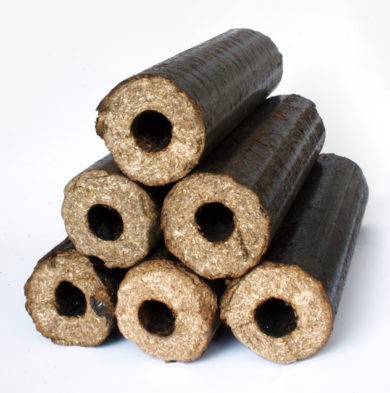On average, the United States produces about 250 million tons of solid waste every year. More than half that waste is organic material like paper, paperboard, yard trimmings, or byproducts from the agricultural and forestry industries. Otherwise known as biomass, this organic material can be formed into biomass briquettes that can contend or coexist with traditional combustibles.
What Is a Biomass Briquette?
The biomass briquette recipe is relatively straightforward. The briquettes are the product of the low-pressure compaction of biomass like sawdust, agricultural waste, paper, etc. This compression process allows the biomass to burn longer than if it were left loose. When formed correctly, compressed biomass can burn at the same temperatures and for an equal duration as wood, pellets, or coal.
To prepare the raw materials for the compression process, the organic materials are separated for their burning properties and characteristics and then broken down or shredded into a coarse powder-like sawdust. This powder is then forced through a high or low-pressure power-driven press which heats the powder and forces it through a die. Dependent on the need of the end user, the briquettes are shaped into different shapes and sizes that range from large, uniform, solid briquettes to smaller pellets.
The Real Benefits of Biomass Briquettes
Imagine burning a fuel source in your boiler that provides more energy for your dollar than coal while also emitting fewer toxic greenhouse gasses. Biomass briquettes are environmentally-friendly, entirely renewable, and easy to implement. They can be used to boil water and create steam energy, propel turbines for electricity and even heat homes and businesses.
With little-to-no mechanical preparation, you can burn biomass briquettes in boilers and ovens built with coal or wood in mind. You can even burn coal and biomass together if you prefer. Biomass briquettes can easily handle any process for which you would rely on wood or coal and can be customized to meet your specific needs. They can be used (and even created) on a personal level, or they can scale to power whole businesses and even cities.
Lastly, biomass briquettes reduce the need to import and export fossil fuels across the globe because they can be made domestically with a local plant, animal and municipal solid waste.
General Kinematics Is Your VibratoryExpert
When it comes to the process of sifting, separating, and preparing your biomass for its transition into energy, you can rely on General Kinematics’ extensive line of vibratory equipment. We’ve got a full range of state-of-the-art equipment you cannot find elsewhere. That technological advantage plus decades of experience are a winning combination that will help you make the most of a biomass-to-energy solution.
Get in touch with one of our GK team members today and let us show you how we can revolutionize the way you operate.








